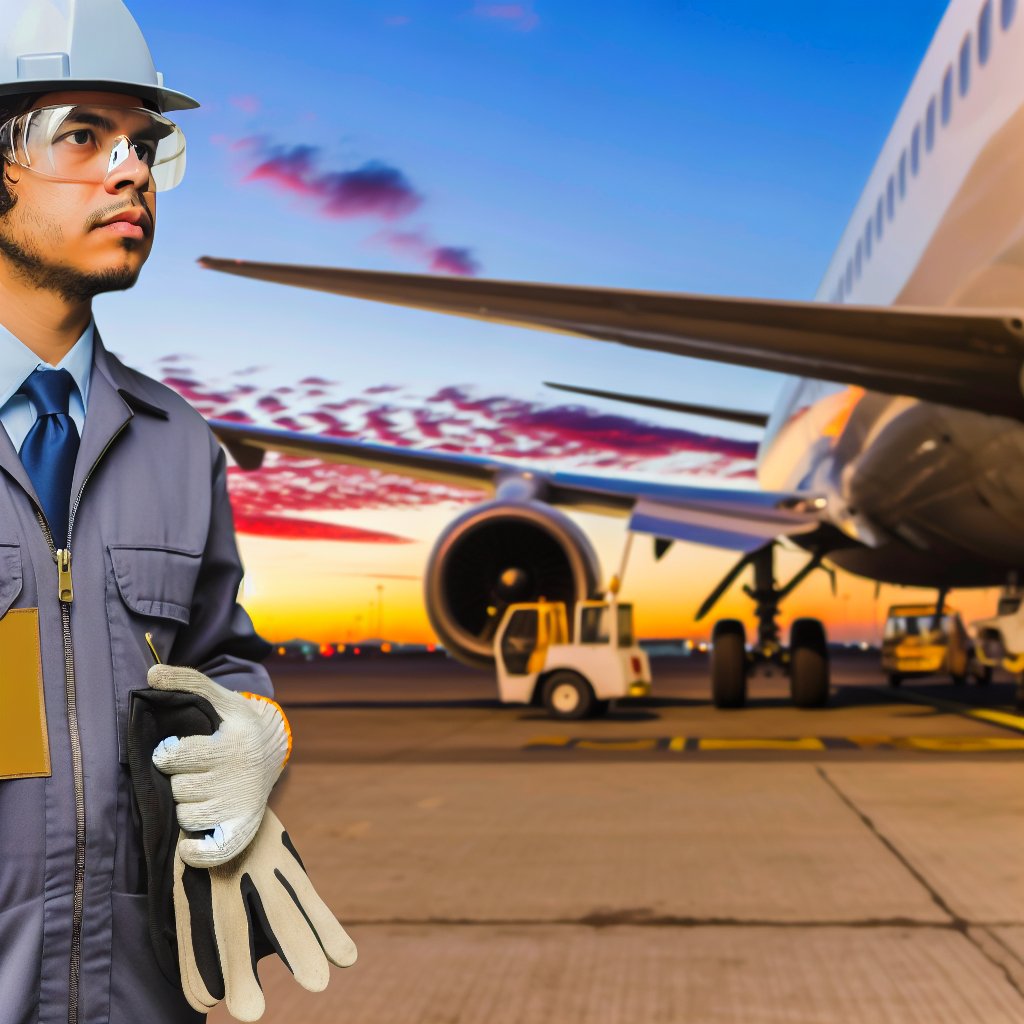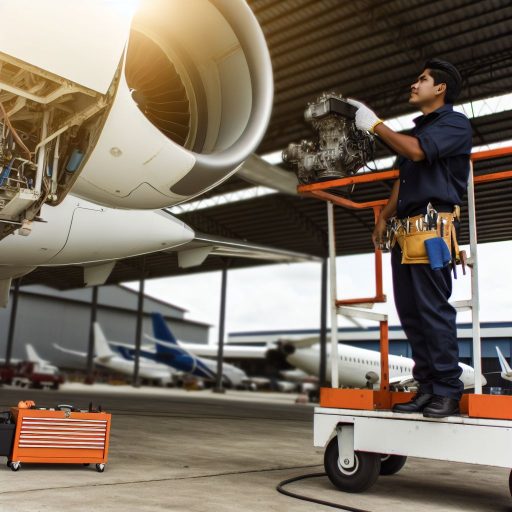Introduction
Aircraft maintenance technicians play a critical role in ensuring the safety and airworthiness of aircraft.
Safety protocols are essential in aviation maintenance to prevent accidents and ensure the well-being of passengers and crew.
Statistics show that a significant number of aviation accidents are caused by human error, including instances where safety protocols were not followed.
This underscores the importance of strict adherence to safety procedures in the industry.
Regulations and guidelines set by aviation authorities such as the Federal Aviation Administration (FAA) are designed to ensure safe practices in aviation maintenance.
Compliance with these regulations is crucial to maintaining the highest safety standards in the industry.
Importance of Personal Protective Equipment (PPE)
Personal Protective Equipment (PPE) is crucial for aviation maintenance technicians to ensure their safety while working on aircraft.
PPE includes various items that protect against hazards in the aviation industry.
Explanation of Various PPE Required for Aviation Maintenance Technicians
- Safety Glasses: Protects eyes from flying debris and chemicals.
- Ear Protection: Reduces noise exposure, preventing hearing damage.
- Gloves: Prevents cuts, burns, and chemical exposure.
- Respiratory Protection: Filters out harmful fumes and particles.
- Steel-Toed Boots: Protects feet from heavy objects and electrical hazards.
Benefits of Wearing PPE in Preventing Accidents and Injuries
- Reduces the risk of eye injuries from debris or chemicals.
- Prevents hearing loss due to prolonged exposure to loud noise.
- Minimizes hand injuries from cuts, burns, or chemical exposure.
- Protects lungs from inhaling harmful fumes or particles.
- Prevents foot injuries from heavy objects or electrical hazards.
Training on Proper Usage and Maintenance of PPE
It is essential for aviation maintenance technicians to receive proper training on how to use and maintain their PPE effectively.
- Clear instructions on how to wear each type of PPE correctly.
- Proper storage and maintenance procedures for PPE items.
- Regular inspections to ensure PPE is in good condition.
- Training on when to replace damaged or worn-out PPE.
By wearing PPE and following proper usage and maintenance procedures, aviation maintenance technicians can significantly reduce their risk of accidents and injuries in the workplace.
It is essential for both employers and employees to prioritize safety by ensuring that appropriate PPE is provided, worn, and maintained correctly.
Hazard Communication
Understanding and identifying hazardous materials in aviation maintenance is crucial for safety.
Warning signs, labels, and data sheets are communication methods for hazardous materials.
Training sessions are essential to teach technicians how to handle hazardous materials safely.
- Understanding and identifying hazardous materials in aviation maintenance is crucial for safety.
- Warning signs, labels, and data sheets are communication methods for hazardous materials.
- Training sessions are essential to teach technicians how to handle hazardous materials safely.
Gain More Insights: Packaging Engineer vs. Industrial Engineer
Lockout/Tagout Procedures
When it comes to aviation maintenance, lockout/tagout procedures are critical for safety and prevention of accidents.
Let’s delve into the details of this important process.
Explanation of the Lockout/Tagout Process
- Lockout/tagout is a safety procedure used to ensure that dangerous machines are properly shut off and not able to be started up again prior to the completion of maintenance or servicing work.
- This process involves isolating energy sources and placing a lock or tag on them to prevent accidental activation while work is being done on the equipment.
- Lockout devices are physical barriers that use locks or chains to restrict access to energy sources, while tags provide warning information to personnel.
Importance of Following Proper Procedures
- Following proper lockout/tagout procedures is crucial for preventing serious accidents, injuries, or even fatalities that could occur if equipment is energized unexpectedly.
- Maintaining awareness of the status of energy sources during maintenance tasks helps to minimize risks and ensure the safety of maintenance technicians.
- Accidental energization or startup of equipment can lead to electrocution, burns, crushing injuries, or other catastrophic consequences.
Training on Correct Steps for Locking and Tagging Out Equipment
- Aviation maintenance technicians must receive thorough training on the correct steps for locking and tagging out equipment before performing work on aircraft.
- This training should include proper identification of energy sources, understanding of lockout/tagout devices, and knowledge of specific procedures for different types of equipment.
- Technicians should be able to recognize when lockout/tagout procedures are necessary and confidently implement them to ensure their own safety and the safety of others.
By following strict lockout/tagout procedures, aviation maintenance technicians can significantly reduce the risk of accidents and injuries while working on aircraft equipment.
Proper training and adherence to safety protocols are key to maintaining a safe working environment in the aviation industry.
Explore Further: Work Environment for Transportation Analysts
Transform Your Career Today
Unlock a personalized career strategy that drives real results. Get tailored advice and a roadmap designed just for you.
Start NowFall Protection
When it comes to aviation maintenance, fall protection measures play a crucial role in ensuring the safety of maintenance technicians.
Falls from heights can result in serious injuries or even fatalities, making it essential to implement proper precautions.
Importance of Fall Protection Measures in Aircraft Maintenance
Working on aircraft can often involve tasks at elevated heights, such as on wings, fuselage, or tail sections.
Without the necessary fall protection measures in place, technicians are at risk of falling and suffering severe injuries.
By implementing reliable fall protection systems, the risk of accidents can be significantly reduced.
This not only ensures the safety of maintenance technicians but also contributes to the overall efficiency and effectiveness of maintenance operations.
Use of Safety Harnesses, Guardrails, and Safety Nets
One of the most common fall protection measures in aviation maintenance is the use of safety harnesses.
A safety harness consists of straps worn around the body that are connected to a secure anchor point to prevent falls.
In addition to safety harnesses, guardrails are often installed around elevated work areas to act as a barrier against falls.
Safety nets can also be used as a secondary measure to catch a technician in the event of a fall.
It is crucial to ensure that safety harnesses, guardrails, and safety nets are regularly inspected and maintained to guarantee their effectiveness in preventing falls.
Any signs of wear or damage should be addressed promptly to avoid compromising safety.
Training on How to Properly Use Fall Protection Equipment and Techniques
Proper training is essential for maintenance technicians to understand how to correctly use fall protection equipment and techniques.
This training should cover how to inspect, don, and adjust safety harnesses to ensure a secure fit.
Technicians should also be trained on the importance of anchoring their safety harnesses to strong and secure anchor points.
Improper anchoring can lead to equipment failure during a fall, putting the technician at risk of serious injury.
Regular training sessions should be conducted to reinforce safe practices and familiarize technicians with the latest fall protection equipment and techniques.
This ongoing training is vital to ensure that maintenance technicians are well-prepared to work safely at elevated heights.
Fall protection is a critical aspect of aviation maintenance safety.
By implementing proper fall protection measures, using safety harnesses, guardrails, and safety nets, and providing thorough training on their use, maintenance technicians can effectively mitigate the risks associated with working at heights and ensure a safe work environment.
Transform Your Career Today
Unlock a personalized career strategy that drives real results. Get tailored advice and a roadmap designed just for you.
Start NowDelve into the Subject: Key Performance Metrics for Freight Agents
Importance of Fire Prevention and Control in Aviation Maintenance
Fire safety is crucial in aviation maintenance to protect personnel and assets from potential disasters.
Aviation maintenance facilities house flammable materials and equipment, making them susceptible to fire hazards.
Failure to adhere to strict fire safety protocols can result in severe damage, injuries, or even fatalities.
Training on Handling Fire Emergencies, Use of Firefighting Equipment, and Evacuation Procedures
Aviation maintenance technicians must undergo comprehensive training on fire safety protocols and procedures.
This training should include hands-on experience with firefighting equipment such as extinguishers, hoses, and blankets.
Technicians should be well-versed in evacuation procedures to ensure a swift and orderly response in case of a fire.
Importance of Regular Fire Drills and Training Exercises
Regular fire drills are essential to ensure that aviation maintenance technicians are well-prepared for emergencies.
These drills help assess the effectiveness of existing protocols and identify areas for improvement.
Consistent training exercises also help maintain a high level of readiness and response proficiency among technicians.
Discover More: Ethical Considerations in Supply Chain Analysis

Tool and Equipment Safety
When it comes to aviation maintenance technicians, ensuring tool and equipment safety is crucial for the overall safety of aircraft and passengers alike.
- Importance of proper tool and equipment inspection before use: Before starting any maintenance task, technicians must thoroughly inspect tools and equipment to ensure they are in proper working condition.
- Training on maintenance, calibration, and safe handling of tools: Technicians should receive comprehensive training on how to maintain, calibrate, and safely handle various tools they use during maintenance procedures.
- Importance of reporting damaged or malfunctioning tools immediately: If a technician notices any damage or malfunction in a tool, it is crucial to report it immediately to prevent accidents or errors during maintenance tasks.
By following these protocols and procedures, aviation maintenance technicians can help maintain a safe working environment and ensure the reliability and safety of the aircraft they work on.
Ergonomics and Injury Prevention
Aviation maintenance technicians often spend hours working on aircraft. This task can lead to the development of repetitive strain injuries. Implementing proper ergonomics is crucial. It helps in preventing such injuries and ensures the well-being of technicians.
Importance of Proper Ergonomics
- Proper ergonomics involves creating a work environment that minimizes strain on the body.
- Implementing ergonomic principles can help reduce the risk of musculoskeletal disorders.
- By investing in ergonomic equipment and workstation design, aviation maintenance facilities can enhance health and productivity.
Training on Proper Lifting Techniques, Posture, and Workstation Setup
- Aviation maintenance technicians should receive training on how to lift heavy objects safely.
- Proper posture is essential to avoid strain on the neck and back.
- Workstation setup plays a crucial role. Adjustable chairs, desks, and tools should be provided.
Importance of Regular Breaks and Stretching Exercises to Prevent Injuries
- Taking regular breaks throughout the workday allows technicians to rest and recharge.
- Stretching exercises help improve flexibility and relieve muscle tension.
- Encouraging a culture of wellness can lead to a more engaged workforce.
By prioritizing ergonomics and injury prevention, aviation maintenance technicians can enjoy a safer and more comfortable work environment. This focus leads to improved job satisfaction and performance.
Aviation Maintenance Safety Protocols
As aviation maintenance technicians, it is crucial to adhere to key safety protocols to ensure the safety of aircraft and personnel.
This adherence helps in preventing accidents and upholding the highest standards of safety in the industry.
Continuous training and education on safety practices are essential in staying updated and informed.
Prioritizing safety in all aspects of aviation maintenance operations should be a top priority.
Additional Resources
Transform Your Career Today
Unlock a personalized career strategy that drives real results. Get tailored advice and a roadmap designed just for you.
Start Now



